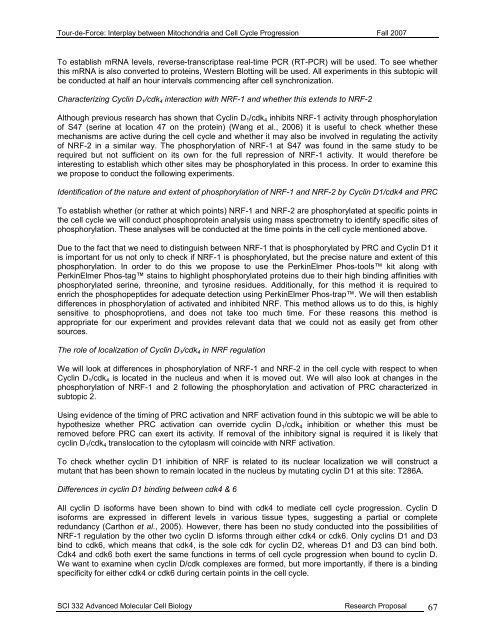Tour-de-Force
Tour-de-Force
Tour-de-Force
Create successful ePaper yourself
Turn your PDF publications into a flip-book with our unique Google optimized e-Paper software.
<strong>Tour</strong>-<strong>de</strong>-<strong>Force</strong>: Interplay between Mitochondria and Cell Cycle Progression Fall 2007To establish mRNA levels, reverse-transcriptase real-time PCR (RT-PCR) will be used. To see whetherthis mRNA is also converted to proteins, Western Blotting will be used. All experiments in this subtopic willbe conducted at half an hour intervals commencing after cell synchronization.Characterizing Cyclin D 1 /cdk 4 interaction with NRF-1 and whether this extends to NRF-2Although previous research has shown that Cyclin D 1 /cdk 4 inhibits NRF-1 activity through phosphorylationof S47 (serine at location 47 on the protein) (Wang et al., 2006) it is useful to check whether thesemechanisms are active during the cell cycle and whether it may also be involved in regulating the activityof NRF-2 in a similar way. The phosphorylation of NRF-1 at S47 was found in the same study to berequired but not sufficient on its own for the full repression of NRF-1 activity. It would therefore beinteresting to establish which other sites may be phosphorylated in this process. In or<strong>de</strong>r to examine thiswe propose to conduct the following experiments.I<strong>de</strong>ntification of the nature and extent of phosphorylation of NRF-1 and NRF-2 by Cyclin D1/cdk4 and PRCTo establish whether (or rather at which points) NRF-1 and NRF-2 are phosphorylated at specific points inthe cell cycle we will conduct phosphoprotein analysis using mass spectrometry to i<strong>de</strong>ntify specific sites ofphosphorylation. These analyses will be conducted at the time points in the cell cycle mentioned above.Due to the fact that we need to distinguish between NRF-1 that is phosphorylated by PRC and Cyclin D1 itis important for us not only to check if NRF-1 is phosphorylated, but the precise nature and extent of thisphosphorylation. In or<strong>de</strong>r to do this we propose to use the PerkinElmer Phos-tools kit along withPerkinElmer Phos-tag stains to highlight phosphorylated proteins due to their high binding affinities withphosphorylated serine, threonine, and tyrosine residues. Additionally, for this method it is required toenrich the phosphopepti<strong>de</strong>s for a<strong>de</strong>quate <strong>de</strong>tection using PerkinElmer Phos-trap. We will then establishdifferences in phosphorylation of activated and inhibited NRF. This method allows us to do this, is highlysensitive to phosphoprotiens, and does not take too much time. For these reasons this method isappropriate for our experiment and provi<strong>de</strong>s relevant data that we could not as easily get from othersources.The role of localization of Cyclin D 1 /cdk 4 in NRF regulationWe will look at differences in phosphorylation of NRF-1 and NRF-2 in the cell cycle with respect to whenCyclin D 1 /cdk 4 is located in the nucleus and when it is moved out. We will also look at changes in thephosphorylation of NRF-1 and 2 following the phosphorylation and activation of PRC characterized insubtopic 2.Using evi<strong>de</strong>nce of the timing of PRC activation and NRF activation found in this subtopic we will be able tohypothesize whether PRC activation can overri<strong>de</strong> cyclin D 1 /cdk 4 inhibition or whether this must beremoved before PRC can exert its activity. If removal of the inhibitory signal is required it is likely thatcyclin D 1 /cdk 4 translocation to the cytoplasm will coinci<strong>de</strong> with NRF activation.To check whether cyclin D1 inhibition of NRF is related to its nuclear localization we will construct amutant that has been shown to remain located in the nucleus by mutating cyclin D1 at this site: T286A.Differences in cyclin D1 binding between cdk4 & 6All cyclin D isoforms have been shown to bind with cdk4 to mediate cell cycle progression. Cyclin Disoforms are expressed in different levels in various tissue types, suggesting a partial or completeredundancy (Carthon et al., 2005). However, there has been no study conducted into the possibilities ofNRF-1 regulation by the other two cyclin D isforms through either cdk4 or cdk6. Only cyclins D1 and D3bind to cdk6, which means that cdk4, is the sole cdk for cyclin D2, whereas D1 and D3 can bind both.Cdk4 and cdk6 both exert the same functions in terms of cell cycle progression when bound to cyclin D.We want to examine when cyclin D/cdk complexes are formed, but more importantly, if there is a bindingspecificity for either cdk4 or cdk6 during certain points in the cell cycle.SCI 332 Advanced Molecular Cell Biology Research Proposal 67
















